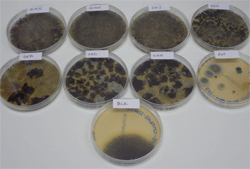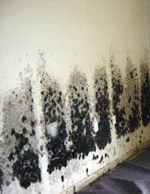
Mold in home can be nerve-wracking if you either suspect or know that mold is growing in your home. Mold in home is unsightly and it destroys any material it grows on including clothes and shoes.

Mold in home will grow on damp walls, wallpaper, PVC/paper wall covering, gypsum board, dust (from floor, carpet and mattress, and upholstered-furniture), acrylic paint, UFFI, leather, HVAC insulation, filters and fans, humidifier water, leather, fabrics, bird droppings, potted plant soil, plastic, and wood. As mold grows it produces spores that become airborne and finally settle on surfaces including the carpet. The amount of spores in the air significantly increases when cleaning is carried out mechanically, for example, when carpets are vacuum cleaned. Some mold species are more prevalent indoors than others. A small number of indoor molds will cause allergy symptoms while others will not only cause allergy symptoms but also produce toxic compounds (mycotoxins).
One important thing to know is that if the mold in home covers a large area, bigger than 10 square feet (1 square meter), it is highly recommended that you seek out a mold remediation professional. An area this size or larger should be dealt with using certain safety procedures and precautions. You may be interested to read Frequently Asked Mould Questions.
Mold in Home On Walls and Structure
When mold grows, it needs a source of moisture and a source of food. On walls, it usually gets its moisture from leaks or moisture absorbed by the wall from the surrounding air. Its food comes from the wood, paper materials and even dust on the wall. Finding and fixing the water problem first is very important.
After dealing with the water, the mold can be dealt with. Mold can be more than just a health hazard in a wall — it can actually degrade and weaken the materials of the wall so that they are not structurally sound. If you suspect this, it is important to have a home inspector or other qualified professional look at the damage.
Things like wallbeams can be cleaned with a solution of detergent and water, then rinsed and dried thoroughly. Things like fibreglass, once contaminated, must be replaced as there is no way to decontaminate them effectively.
Mold in Home On Furniture

Another concern, of course, is the furniture in the room. If you have mold growing in or on the walls, you don’t necessarily have any on your furniture. If you want to be sure or if the furniture has been up against the contaminated wall or area, it may be best to check for signs of mold growth on the furniture. If you find any, many types of furniture can be cleaned with detergent and water, then dried. Soft furnishings that can be thrown in the washing machine should be treated that way. Items like mattresses which cannot be put in the washing machine should probably be replaced if they become contaminated.
Mold in Home On Clothing
Clothing is very easy to deal with. It can be washed in the washing machine, which will remove any mold or spores. If there was staining due to mold growth, this may or may not come out in the wash, but it is just a stain and does not mean that mold is still on the clothing after it has been washed.
In all cases, when handling items or areas that are contaminated by mold, it is best to protect yourself. Wear gloves and a mask if you can.

Leave a Reply
You must be logged in to post a comment.